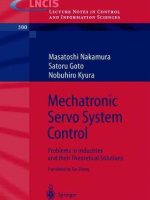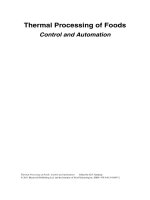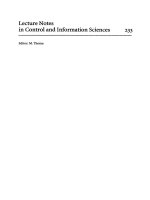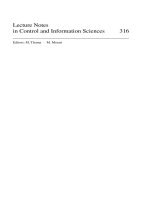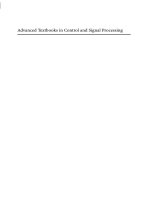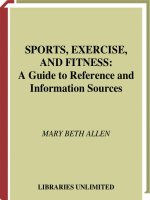Control and Information Sciences ppt
Bạn đang xem bản rút gọn của tài liệu. Xem và tải ngay bản đầy đủ của tài liệu tại đây (16.36 MB, 284 trang )
Lecture Notes
in Control and Information Sciences
236
Editor: M. Thoma
Anibal T. de Almeida and Oussama Khatib (Eds)
Autonomous
Robotic Systems
~ Springer
Series Advisory Board
A. Bensoussan • M.J. Grimble
I.L. Massey • Y.Z. Tsypkin
P. Kokotovic • H. Kwakernaak
Editors
Professor Anibal T. de Almeida
Instituto de Sistemas e Rob6tica
Departamento de Engenharia Electrot~cnica, Universidade de Coimbra,
Polo II, 3030 Coimbra, Portugal
Professor Oussama Khatib
Department of Computer Science, University of Stanford, Palo Alto, CA 94305,
USA
ISBN 1-85233-036-8 Springer-Verlag Berlin Heidelberg New York
British Library Cataloguing in Publication Data
Autonomous robotic systems. (Lecture notes in control and
information
sciences
; 236)
1.Robotics 2.Automation
I.Almeida, Anibal T. de II.Khatib, O. (Oussama)
629.8'92
ISBN 1852330368
Library of Congress Cataloging-in-Publication Data
A catalog record for this book is available from the Library of Congress
Apart from any fair dealing for the purposes of research or private study, or criticism or review, as
permitted under the Copyright, Designs and Patents Act 1988, this publication may only be reproduced,
stored or transmitted, in any form or by any means, with the prior permission in writing of the
publishers, or in the case of reprographic reproduction in accordance with the terms of licences issued
by the Copyright Licensing Agency. Enquiries concerning reproduction outside those terms should be
sent to the publishers.
© Springer-Verlag London Limited 1998
Printed in Great Britain
The use of registered names, trademarks, etc. in this publication does not imply, even in the absence of a
specific statement, that such names are exempt from the relevant laws and regulations and therefore
free for general use.
The publisher makes no representation, express or implied, with regard to the accuracy of the
information contained in this book and cannot accept any legal responsibility or liability for any errors
or omissions that may be made.
Typesetting: Camera ready by editors
Printed and bound at the Athenaeum Press Ltd., Gateshead, TDae & Wear
6913830-543210 Printed on acid-free paper
Preface
The Advanced Research Workshop on
"Autonomous Robotic Systems"
was held in
the University of Coimbra, in Cohrkbra, Portugal, from June 19 to 21, 1997. The
aim of this meeting was to bring together leading researchers from around the
world to present and discuss the recent developments in the area of autonomous
systems for mobility and manipulation. The presentations at the workshop were
made by researchers from Europe, Asia, and North America, and the meeting was
attended by 80 participants from 15 countries.
Autonomous robotic systems have been the focus of much attention in recent years
and significant progress has been made in this growing area. These efforts have
resulted in a host of successful applications. However, there is a vast potential for
new applications, which require further research and technological advances.
This volume includes the key contributions presented at the workshop. These
contributions represent a wide coverage of the state-of-the-art and the emerging
research directions in autonomous robotic systems. The material was developed in
an advanced tutorial style making its contents more accessible to interested
readers. These contributions are organised in four parts: Sensors and Navigation,
Cooperation and Telerobotics, Applications, and Legged and Climbing Robots.
The first part concerns sensors and navigation in mobile robotics. An effective
navigation system developed for natural unstructured environments, as well as its
implementation results on a cross-country rover, are presented. Various active
vision systems, with potential application to surveillance tasks, are described, and
the integration of active vision in mobile platforms is analysed. A survey of
sensors for mobile robot navigation is presented. The synergy of combining
inertial sensors with absolute sensors seems to overcome the limitations of either
type of systems when used alone. The emerging area of odour sensors in mobile
robotics, based on biological systems, is also analysed.
The second part focuses on cooperation and telerobotics. Different approaches for
the generation of smooth robot motion and desired forces in a natural way, are
outlined. Issues of position versus velocity control are discussed and alternatives
to force-reflection and pure force feed-forward are described. Cooperation is
vI
central to distributed autonomous robot systems. The development of cooperative
behaviours is discussed from a local and global coordination point of view and
new cooperation methodologies are proposed. Mobile manipulation capabilities
are key to many new applications of robotics. The inertial properties of holonomic
mobile manipulation systems are discussed, and the basic strategies developed for
their dynamic coordination and control are presented.
The third part is devoted to applications. Existing and emerging new applications
of autonomous systems are discussed. These applications include operations in the
forestry sector, floor cleaning in buildings, mining industry, hospitals and tertiary
buildings, assistance to the elderly and handicapped, and surgery.
The fourth part is concemed with legged and climbing robots. These machines are
becoming increasingly important for dealing with highly irregular environments
and steep surfaces. A survey of walking and climbing machines, as well as the
characterisation of machines with different configurations, are presented.
On behalf of the Organising Committee, we would like to express our appreciation
and thanks to the European Commission, Junta Nacional de Investigacao
Cientifica e Tecnologica, FLAD, and the University of Coimbra, for the financial
support they extended to this workshop. Also we would like to thank the
University of Coimbra and the Department of Electrical Engineering for hosting
the workshop.
Our special thanks go to the researchers, staff, and students of the Institute of
Systems and Robotics, who generously gave of their time to help in the
organisation of this meeting.
The Editors
Anibal T. de Almeida
Oussama Khatib
February, 1998
Contents
Preface v
Part I - Sensors and Navigation
Autonomous Outdoor Mobile Robot Navigation: The EDEN Project 3
Raja Chatila, Simon Lacroix, Michel Devy, Thierry Simdon
Active Vision for Autonomous Systems 21
Helder ]. Ara~jo, ]. Dias, ]. Batista, P. Peixoto
Sensors for Mobile Robot 51
]orge Lobo, Lino Marques, ]. Dias, U. Nunes, A.T. de Almeida
Application of Odour Sensors in Mobile Robotics 83
Lino Marques, A.T. de Almeida
Part II -
Cooperation and
Telerobotics
Advanced Telerobotics 99
G. Hirzinger, B. Brunner, R. Koeppe, ]. Vogel
Cooperative Behaviour Between Autonomous Agents 125
Toshio Fukuda, Kosuke Sekiyama
Mobile Manipulator Systems 141
Oussama Khatib
Part III- Applications
Forestry Robotics - Why, What and When 151
Aarne Halme, Mika Vainio
Robotics for the Mining Industry 163
Peter L Corke, Jonathan M. Roberts, Graeme ]. Winstanley
viii
HelpMate@, the Trackless Robotic Courier: A Perspective on the
Development of a Commercial Autonomous Mobile Robot
John M. Evans, Bala Krishnamurthy
Intelligent Wheelchairs and Assistant Robots
]osep Amat
Robots in Surgery
Alicia Casals
Part IV - Legged and Climbing Robots
Legged
Walking Machines
Friedrich Pfeiffer, Steuer loser, Thomas Roflmann
Climbing Robots
Gurvinder S. Virk
182
211
222
237
264
Part One
Sensors and Navigation
Autonomous Outdoor Mobile Robot Navigation: The EDEN Project
Raja Chatila, Simon Lacroix, Michel Devy, Thierry Simeon
Active Vision for Autonomous Systems
HeIder ]. Ara~jo, ]. Dias, ]. Batista, P. Peixoto
Sensors for Mobile Robot
]orge Lobo, Lino Marques, ]. Dias, U. Nunes, A.T. de Almeida
Application of Odour Sensors in Mobile Robotics
Lino Marques, A.T. de Almeida
The EDEN Project
Navigation
Raja Chatila Simon Lacroix Michel Devy
Thierry Sire@on
LAAS-CNRS
7, Ave. du Colonel Roche
31077 Toulouse Cedex 4, France
E-mail: {raj a,simon,michel,nic}~laas.fr
Abstract
A cross-country rover cannot rely in general on permanent and im-
mediate communications with a control station. This precludes direct
teleoparation of its motions. It has therefore to be endowed with a large
autonomy in achieving its navigation. We have designed and experimented
with the mobile robot ADAM a complete system for autonomous navi-
gation in a natural unstructured environment. We describe this work in
this paper. The approach is primarly based on the adaptation of the per-
ception and motion actions to the environment and to the status of the
robot. The navigation task involves several levels of reasoning, several en-
vironment representations, and several action modes. The robot is able to
select sub-goals, navigation modes, complex trajectories and perception
actions according to the situation.
1 Introduction
Navigation is the basic task that has to be solved by a cross-country rover.
Effectiveness in achieving the task is essential given the constraints of energy.
Navigation is in general an incremental process that can be summarized in four
main steps:
• Environment perception and modelling: any motion requires a representa-
tion of the local environment at least, and often a more global knowledge.
The navigation process has to decide where, when and what to perceive.
• Localization: the robot needs to know where it is with respect to its
environment and goal.
• Motion decision and planning: the robot has to decide where or which way
to go, locally or at the longer term, and if possible compute a trajectory
for avoiding obstacles and terrain difficulties;
• Motion execution: the commands corresponding to the motion decisions
are executed by control processes - possibly sensor-based and using envi-
ronment features.
The complexity of the navigation processes depends on the general context
in which this task is to be executed (nature of the environment, efficiency con-
straints, ) and should be adapted to it.
Navigation in outdoors environments was addressed either for specific tasks,
e.g., road following [8], or motion in rather limited environment conditions [9,
10]. Ambler [4] is a legged machine and the main problem was computing
footholes. The UGV, as well as Ratler [4] achieve autonomous runs avoiding
obstacles, but not coping to our knowledge with irregular terrain.
In a natural outdoor environment, the robot has to cope with different kinds
of terrain: flat with scattered rocks or irregular/uneven in which its motion
control system should take into account its stability. Limitations of computing
capacities (processing power and memory) and of power consumption on the
one hand, and the objective of achieving an efficient behaviour on the other
hand, have lead us to consider an
adaptive
approach to mobile robot navigation
in natural environments.
The objective of the EDEN project described here is to achieve a canonical
navigation task, i.e., the task: ' 'Go To [goal] ' ', where the argument goal is
a distant target to reach autonomously. Any more complex robotic mission (ex-
ploration, sample collection ) will include one or more instances of this task.
Given the variety of terrains the robot will have to traverse, this task involves
in our approach several levels of reasoning, several environment representations,
and various motion modes. It raises a need for a specific decisional level (the
navigation
level), that is in charge of deciding which environment representa-
tion to update, which sub-goal to reach, and which motion mode to apply. This
level, which is a key component of the system, controls the perception and
motion activities of the robot for this task.
The paper is organised as follows: the next section presents the adaptive
approach to autonomous navigation in unknown outdoor environments. Sec-
tion 3 then mentions the various terrain models required during navigation, and
presents how the terrain representations required by the navigation decisional
level and for the purpose of localization are incrementally built. The algorithms
that produce motion plans, both at the navigation and trajectory level, are de-
scribed in section 4. Finally, we present experimental results and conclude the
paper.
2
A General Strategy for Navigation in Outdoor
Unknown Environments
2.1 An adaptive approach
Using its own sensors, effectors, memory and computing power efficiently is
certainly a feature that we would like to implement in a robot. This becomes
even more a necessity for a rover (such as a planetary rover for instance) whic~
has important limitations on its processing capacities, memory and energy, rio
achieve an efficient behavior, the robot must adapt the manner in which it
executes the navigation task to the nature of the terrain and the quality of its
knowledge on it [2, 5]. Hence, three motion modes are considered:
• A reflex mode: on large flat and lightly cluttered zones, it is sufficient to
determine robot locomotion commands on the basis of a goal (heading or
position) and informations provided by "obstacle detector" sensors. The
terrain representation required by this mode is just the description of the
borders of the region within which it can be applied;
• A 2D planned mode: when the terrain is mainly flat, but cluttered with
obstacles, it becomes necessary for efficiency reasons to plan a trajectory.
The trajectory planner reasons on a binary description of the environment,
which is described in terms of empty/obstacle areas.
• A 3D planned mode: when the terrain is highly constrained (uneven),
collision and stability constraints have to be checked to determine the
robot locomotion commands. This is done thanks to a 3D trajectory plan-
ner 4.2, that reasons on a fine 3D description of the terrain (an elevation
map or numerical terrain model [6]);
The existence of different motion modes enables more adpated and efficien~
behavior, at the price of complicating the system since it must be able to deal
with several different terrain representations and motion planning processes. It
must especially have the ability to determine which motion mode to apply: this
is performed thanks to a specific planning level, the
navigation planner
which
requires its own representations.
2.2 The Navigation Planner
We assume the terrain on which the robot must navigate is initially unknown:
or mapped with a very low resolution. In this last case, it is possible for a user
to specify a graph of possible
routes, i.e.
corridors that avoid large difficult
areas, and within which the robot has to move autonomously. In this context,
the navigation task ' 'Co To' ' is achieved at three layers of planning (figure
1):
• route planning
which selects long-term paths to the goal on the basis
of the initial informations when available (the route map that may cover
Route
planning
/ = ,
@ Goal
~
Forbidden area
Planned motion
Executed motion
Figure 1:
Three levels of planning
several kilometers). The route planner selects a sub-goal for the navigation
planning level;
navigation planning
which reasons on a global qualitative representation
of the terrain, built from the data acquired by the robot's sensors. The
navigation planner selects the next perception task to perform, the sub-
goal to reach and the motion mode to apply: it selects and controls the
trajectory planner;
trajectory planning
which determines the trajectory to execute (in one of
the above-mentioned three motion modes) to reach the goal defined by
the navigation planning level.
Splitting the decisional process into three layers of planning has the advan-
tage of structuring the problem: each planning layer controls the one that is
directly below by specifying its goal and its working domain. It has also the
great advantage of helping to analyze failures: when a planner fails to reach
its goal, it means that the environment representation of the immediatly higher
layer is erroneous and therefore that it has to be revised.
The navigation planner (layer 2 - section 4.1) is
systematically
activated
at each step of the incremental execution of the task: each time 3D data are
acquired, they are analyzed to provide a description of the perceived zone in
terms of navigation classes. This description is fused with the model acquired
so far to maintain a
global qualitative representation
of the environment, (the
region map -
section 3.1), on which the navigation planner reasons to select a
sub-goal, a motion mode, and the next perception task to execute.
3 Several terrain representations
Each of the three different motion modes requires a particular terrain represen-
tation. The navigation planner also requires a specific terrain representation,
and during navigation, an exteroceptive localisation process has to be activated
frequently, which requires an other terrain representation. Aiming at building a
"universal" terrain model that contains all the necessary informations for these
various processes is extremely difficult, inefficient, and moreover not really use-
ful. It is more direct and easier to build different representations adapted to
their use: the enviromnent model is then
multi-layered and heterogeneous.
Sev-
eral perception processes coexist in the system, each dedicated to the extraction
of specific representations: perception is
multi-purpose.
/s?- /
REGION MAP
A PRIORI 10~IOW~DGE
DATA PROCESSINGS and INTERMEDIATE MODELS FONCTIONAUTIES
Figure 2:
The various representations used in the system. Arrows represent the constructive
dependencies between them
Figure 2 presents the various terrain representations required during nav-
igation: one can distinguish the numerical terrain model [6] necessary to the
3D trajectory planner, the region map dedicated to the navigation planner,
and three different ways to build a localisation
modeh(i)
by modelling objects
(rocks) with ellipsoids or superquadrics [1],
(ii)
by detecting interesting zones
in the elevation map represented by a B-spline based model [3], or
(iii)
by de-
tecting poles in the 3D raw data. Coherence relationships between these various
representations are to be maintained when necessary.
3.1 Building the region map
For the purpose of navigation planning, a global representation that describes
the terrain in terms of navigation classes (flat, uneven, obstacle, unknown) is
required. This representation enables to select the adequate motion mode. We
focus in this section on the algorithms developed to build such a model from
3D data (produced either by a laser range finder or a correlation stereo-vision
algorithm).
3.1.1 3D data classification
Applied each time 3D data are acquired, the classification process produces
a description of the perceived areas in term in
terrain classes.
It relies on a
specific discretization of the perceived area respecting the sensor resolution (fig-
ure 3), that defines "cells" on which different characteristics (attributes) are
determined: density (number of 3D points in a cell compared with a nomi-
nal density defined by the discretization rates), mean altitude, variance on the
altitude, mean normal vector and corresponding variances
A non-parametric Bayesian classification procedure is used to label each
cell: a learning phase, based on prototypes classified by a human, leads to
the determination of probability density functions, and the classical Bayesian
approach is applied, which provides an estimate of the probability for each
possible label. A decision function that prefers false alarms
(i.e.
labelling a
flat area as obstacle or uneven) instead of the non-detections
(i.e.
the opposite:
labelling an obstacle as a flat area) is used (figure 4). A simpler but faster
technique based on thresholds on the cell attributes has also been implemented.
Figure 3:
Discretlzation used for the classification procedure: a regular discretisation in
the sensor frame (left: a 3D image is represented as a video image, where the gray levels
corresponds to point depth) defines a discretizatlon of the perceived zone that respects the
sensor resolution (right)
This technique proved its efficiency and robustness on several hundreds of
3D images. Its main interest is that it provides an estimate of the confidence
of its results: this information is given by the
entropy
of a celt. Moreover, a
statistical analysis of the cell labelling confidence as a function of its label and
distance to the sensor (directly related to the measure uncertainty) defines a
predictive model of the classification process.
Figure 4:
Classification of a correlated stereo image: correlated pixels (top) and reprojeetion
of the result in the camera frame (bottom - from clear to dark: unknown, flat, uneven and
obstacle)
3.1.2 Incremental fusion
The partial probabilities of a cell to belong to a terrain class and the variance
on its elevation allow to perform a fusion procedure of several classified images.
The fusion procedure is performed on a bitmap, in the pixels of which are
encoded cell attributes determined by the classification procedure (label, label
confidence, elevation and variance on the elevation).
Figure 5:
Fusion of
s different classified laser images: terrain classes (top) and elevation
(bottom)
3.1.3 Model structure and management
For the purpose of navigation planning, the global bitmap model is structured
into a region map, that defines a connection graph. Planning a
path
(as opposed
to planning a
trajectory)
does not require a precise evaluation of the static and
kinematic constraints on the robot: we simply consider a robot point model[,
and therefore perform an obstacle growing in the bitmap before segmenting it
into regions. The regions define a connection graph, whose nodes are on their
borders, and whose arcs correspond to a region crossing (figure 6).
10
Figure 6:
The model of figure 5 after obstacle growing (top} and the nodes defined by the
region segmentation (bottom)
In order to satisfy memory constraints, the global model is explicited as
a bitmap only in the surroundings of the robot's current position, and the
region model (much more compact) is kept in memory during the whole mission
(figure 7).
Figure 7:
Robot surroundings explicited as a bitmap
3.2 Object-based representations
In order to be able to localize itself with respect to environment features, it is
necessary for the robot to build representations of objects that it could recognize
and use as landmarks.
When the terrain has been classified as flat but scattered with obstacles,
we extract by a segmentation process the objects that are lying on the ground.
Some of these objects that are salient and easily recognisable (e.g., peak-like)
can be considered as landmarks for localisation.
To each object corresponds a referential - within which its surface is to be
represented - this referential being itself located in a global coordinate frame in
which it is represented by an uncertain state vector and a variance-covariance
]]
matrix. During navigation, the robot selects some objects possessing remarkab]te
properties (visibility, selectivity, accuracy) that make them easily recognisable,
and uses them as landmarks for anchoring the environment model and to locate
itself. Landmarks will actually be specific features on such objects. As the
robot moves the updating of the model is based on an extended Kalman filter.
To recognize objects and landmarks, we use the two following complementary
criteria:
• Comparison of the global shape and features of the objects (i.e., their in-
trinsic parameters).
Comparison of the relative position of the objects themselves in order to
obtain a consistent set of matchings. This is more interesting for land-
marks because we could extract precise features on them.
A general approach will consist in exploiting the two criteria, but in our
case, objects (mainly rocks) have similar shapes, and the position criterion will
be proeminent.
The feature that defines the landmark is the object top, if it is salient enough.
Landmarks here are local and should be lower that the robot sensor so that we
can guarantee that the topmost point is perceived without ambiguity.
In a segmented 3D image, an object is selected as candidate landmark if:
.
It is not occluded by another object or by the image contour. If this
object is occluded, it will be both difficult to recognize and to have a good
estimate of its top, which may be not in the visible part.
2. Its topmost point is accurate. This is function of sensor noise, resolution
and object top shape.
3. It must be in "ground contact". This is not an essential condition, but i~L
reduces the recognition ambiguity.
In the model, an object is a landmark if it has been classified as landmark
in at least one of its perceptions.
3.2.1 An Example of Landmark Selection
The top part of Figure 8 represents ten objects segmented in a 3D image. Six
objects are selected as landmarks by the robot (objects number 1 to 6). Object
7 has not been selected because it is occluded by the image contour. This is
also the case for object 9 (the hill) which top is not enough precisely defined.
Object 8 is not occluded but it is not precise. Finally, object 10, which is on
the hill, has not been selected because it is not in contact with the ground.
The bottom part of Figure 8 shows the environment map with the six se-
lected landmarks and their corresponding uncertainties (ellipsoid projections~
corresponding to Gaussian distributions drawn at 99%). We can easily notice
that precision decreases when the distance increases.
12
Z?
4
3
lm
6
5
2
Figure 8:
Segmented objects (left) and selected landmarks with their uncertainty according
to sensor noise and resolution and object shape (right)
4 Planning actions
4.1 Navigation planning
Each time 3D data are acquired, classified and fused in the global model, the
robot has to answer the following questions:
• Where to go? (sub-goal selection)
• How to go there? (motion mode selection)
• Where to perceive? (data acquisition control)
• What to do with the acquired data? (perception task selection)
For that purpose, the navigation planner reasons on the robot capabilities
(action models for perception and motion tasks) and the global terrain repre-
sentation.
4.1.1 Planning motion versus planning perception
A straightforward fact is that motion and perception tasks are strongly interde-
pendent: planning and executing a motion requires to have formerly modelled
the environment, and to acquire some specific data, a motion is often necessary
to reach the adequate observation position.
Planning motion tasks in an environment modelled as a connection graph
is quite straightforward: it consists in finding paths in the graph that min-
imise some criteria (time and energy, that are respectively related to the terrain
13
classes and elevation variations). This is easily solved by classical graph search
techniques, using cost functions that express these criteria.
Planning perception tasks is a much more difficult issue: one must be able
to predict the results of such tasks (which requires a model of the perception
processes), and the
utility
of these results to the mission:
Localization processes can be modelled by a simple function that expresses
the gain on the robot position accuracy, as a function of the number and
distances of perceivable landmarks - assuming all landmarks are intrinsi-
cally equally informative;
With the confidence model of the 3D data classification process, one can
predict the amount of information a classification task can provide. But
it is much more difficult to express the utility of a classification task to
reach the goal: the model of the classification task cannot predict
what
will be effectively perceived. It is then difficult to estimate the interest of
these tasks (figure 9).
0,7
0.6
0,5
0.4
0.3
0.2
01
0
/ ]
/
Goal
o
\
'k !
\, i _1
Figure 9:
The confidence model of the classification procedure (left) and the labelling confi-
dence of the terrain model (represented as grey levels in the bottom image) allow to determine
the classification task that mazimises the gain in confidence from a given view point. But the
result o] this task is o] a poor interest to reach the goal
4.1.2 Approach
A direct and brute force approach to answer the former questions would be to
perform a search in the connection graph, in which
all
the possible perception
tasks would be predicted and evaluated at
each
node encountered during the
search. Besides its drastic algorithmic complexity, this approach appeared unre
alistic because of the difficulty to express the utility of a predicted classification
task to reach the goal.
We therefore choose a different approach to tackle the problem: the per
ception task selection is
subordinated
to the motion task. A search algorithm
provides an
optimal
path, that is analyzed afterwards to deduce the perceptions
14
tasks to perform along it. The "optimality" criterion takes here a crucial im-
portance: it is a linear combination of time and energy consumed, weighted by
the terrain class to cross and the confidence of the terrain labelling (figure 10).
f
Fobst(c)
+ oo]-
t
t.un~ ! iFflat(c)
Cflat I ~, ! i
0 Sflat Sobst Srough
c
l
Figure 10:
Weighting functions of an are cost, as a function of the arc label and confidence
Introducing the labelling confidence in the crossing cost of an arc comes to
consider
implicitly
the modelling capabilities of the robot: tolerating to cross
obstacle areas labelled with a low confidence means that the robot is able to
acquire easily informations on this area. Off course, the returned path is not
executed directly, it is analysed according the following procedure:
1. The sub-goal to reach is the last node of the path that lies in a crossable
area;
2. The labels of the regions crossed to reach this sub-goal determine the
motion modes to apply;
3. And finally the rest of the path that reaches the global goal determines
the aiming angle of the sensor.
Controlling localization: the introduction of the robot position uncer-
tainty in the cost function allows to plan localization tasks along the path. The
cost to minimise is the integral of the robot position accuracy as a function of
the cost expressed in terms of time and energy (figure 11)
7-
Figure 11:
Surface to minimise to control localisation tasks
15
4.2 Trajectory planning
Depending on the label of the regions produced by the navigation planner,
the adequate trajectory planner (2D or 3D) is selected to compute the actual
trajectory within these regions.
4.2.1 Flat Terrain
The trajectory is searched with a simplified and fast method, based on bitmap
and potential fields techniques. In a natural environment, and given the un-
certainties of motion, perception and modelling, we consider it sufficient to
approximate the robot by a circle and its configuration space is hence two di-
mensional, corresponding to the robot's position in the horizontal plane. Path
planning is done according the following procedure :
• a binary bitmap
free/obstacle
is first extracted from the global bitmap
model over the region to be crossed;
* a classical wavefront expansion algorithm then produces a distance map
from which the skeleton of the free-space is computed (figure 12);
• the path reaching the sub-goal is obtained by propagating a potential
through this skeleton. This path is finally transformed into a sequence of
line segments and rotations (figure 12).
Figure 12:
The 2D planner: distance to the obstacles (left), skeleton of the free space
(center}, and a trajectory produced by the planner (right}
Search time only depends on the bitmap discretization, and not on the com
plexity of the environment. The final trajectory is obtained within less than 2
seconds (on a Sparc 10) for a 256 × 256 bitmap.
4.2.2 Uneven Terrain
On uneven terrain, irregularities are important enough and the binary partition
into
free/obstacle
areas is not anymore sufficient: the notion of obstacle clearly
depends on the capacity of the locomotion system to overcome terrain irreg-
ularities and also on specific constraints acting on the placement of the robot
!6
over the terrain. The trajectory planner therefore requires a 3D description of
the terrain, based on the elevation map, and a precise model of the robot ge-
ometry in order to produce collision-free trajectories that also guarantee vehicle
stability and take into account its kinematic constraints.
This planner, described in [7], computes a motion verifying such constraints
by exploring a three dimensional configuration space
CS = (x, y, O)
(the
x-y
position of the robot frame and its heading 6). The obstacles are defined in
CS
as the set of configurations which do not verify some of the constraints imposed
to the placement of the robot (figure 13). The ADAM robot is modelled by
a rigid body and six wheels linked to the chassis by passive suspensions. For
a given configuration, its placement results from the interaction between the
wheels and the terrain, and from the balance of the suspensions. The remaining
parameters of the placement vector (the z coordinate, the roll and pitch angles
¢, ¢), are obtained by minimizing an energy function.
Figure 13:
The constraints considered by the 3D planner. From left to right : collision,
stability, terrain irregularities and kinematic constraint
The planner builds incrementally a graph of discrete configurations that can
be reached from the initial position by applying sequences of discrete controls
during a short time interval. Typical controls consist in driving forward or
backwards with a null or a maximal angular velocity. Each arc of the graph
corresponds to a trajectory portion computed for a given control. Only the arcs
verifying the placement constraints mentionned above are considered during the
search. In order to limit the size of the graph, the configuration space is initially
decomposed into an array of small cuboid cells. This array is used during the
search to keep track of small CS-regions which have already been crossed by
some trajectory. The configurations generated into a visited cell are discarded
and therefore, one node is at most generated in each cell.
In the case of incremental exploration of the environment, an additional
constraint must be considered: the existence of unknown areas on the terrain
elevation map. Indeed, any terrain irregularity may hide part of the ground.
When it is possible (this caution constraint can be more or less relaxed), the
path must avoid such unknown areas. If not, it must search the best way
through unknown areas, and provide the best perception point of view on the
way to the goal. The avoidance of such areas is obtained by an adapted weight
of the arc cost and also by computing for the heuristic guidance of the search, a
potential bitmap which includes the difficulty of the terrain and the proportion
of unknown areas around the terrain patches [6].
The minimum-cost trajectory returned by the planner realizes a compromise
"17
Figure 14:
A 31) trajectory planned on a real elevation map
between the distance crossed by the vehicle, the security along the path and a
small number of maneuvers. Search time strongly depends on the difficulty of
the terrain. The whole procedure takes between 40 seconds to a few minutes,
on an Indigo R4000 Silicon Graphics workstation. Figure 14 shows a trajec-
tory computed on a real terrain, where darker areas correspond to interpolated
unknown terrain.
5 Navigation Results
Figure 15:
ADAM in the Geroms test site
The terrain modelling procedures and navigation planning algorithm have
been intensively tested with the mobile robot Adam 1. We performed experi-
ments on the Geroms test site in the French space agency CNES, where Adam
achieved several ' 'Go To [goal] " missions, travelling over 80 meters, avoid-
ing obstacles and getting out of dead-ends (for more details concerning Adam
and the experimental setup, refer to [2]).
1ADAM is property of Framatome and Matra Marconi Space currently lent to LAAS
18
[]
\ :/'
\iS
Figure 16:
The navigation planner explores a dead-end: it first tries to go through the
bottom of the dead-end, which is modelled as an obstacle region, but with a low confidence
level (top); after having perceived this region and confirmed that is must be labelled as obstacle,
the planner decides to go back (bottom)
Figure 16 presents two typical behaviours of the navigation algorithm in a
dead-end, and figure 17 shows the trajectory followed by the robot to avoid this
dead-end, on the terrain model built after 10 data acquisitions.
Figure 17:
A trajectory that avoids a dead-end (80 meters - I0 perceptions)
The navigation planner proved its efficiency on most of our experiments. The
adaptation of the perception and motion tasks to the terrain and the situation
enabled the robot to achieve its navigation task efficiently. By possessing several
representations and planning functions, the robot was able to take the adequate
decisions. However, some problems raised when the planned classification task
did not bring any new information: this happened in some very particular cases
where the laser range finder could not return any measure, because of a very
small incidence angle with the terrain. In these cases, the terrain model is not
modified by the new perception, and the navigation planner re-planned the same
perception task. This shows clearly the need for an explicit sensor model to plan
a relevant perception task. And this generalizes to all the actions of the robot:
the robot control system should possess a model of the motion or perception
actions in order to select them adequately.
